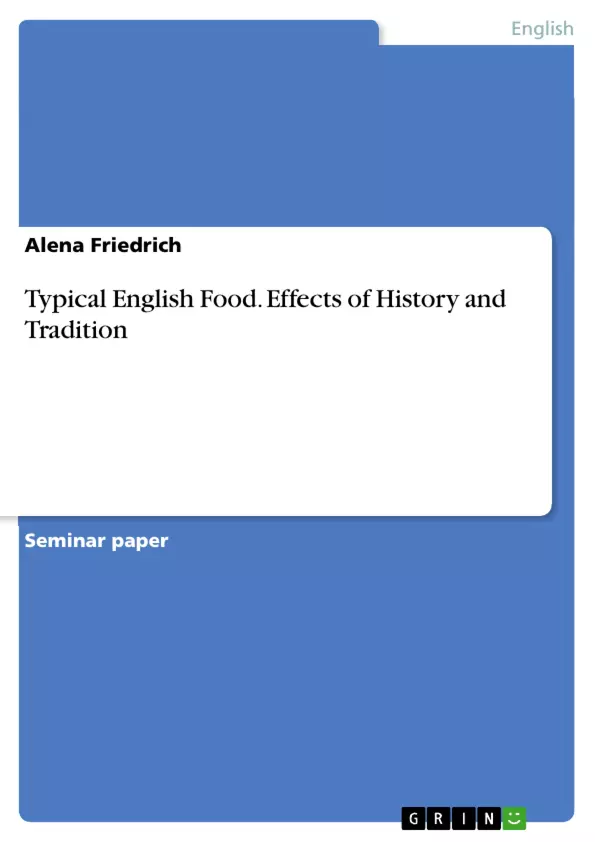Ziel dieser Arbeit ist es, die Ursprünge und Traditionen der englischen Küche zu untersuchen und eventuelle Beziehungen zur Ernährung der Engländer heutzutage aufzuzeigen. Dabei wird die Historie des englischen Essens bis in römische Zeiten zurückverfolgt und ihre Entwicklung dann bis in die heutige Zeit untersucht. Stereotypische Konzepte wie die Vorliebe der Engländer für weißes Brot, Fleisch und der oftmals kritisierte 'fade Geschmack' englischen Essens sollen ebenfalls untersucht werden. Am Ende der Arbeit soll diskutiert werden, ob es so etwas wie 'typisch' englische Küche überhaupt gibt und, wenn ja, worin sich diese widerspiegelt und von, beispielsweise, der schottischen oder walisischen Küche unterscheidet.
Inhaltsverzeichnis (Table of Contents)
- INTRODUCTION
- THE HISTORY OF ENGLISH FOOD
- THE ROMAN ERA
- THE NORMAN / FRENCH ERA
- THE 16TH TO 18TH CENTURY
- THE 19TH CENTURY
- ENGLISH EATING-HABITS TODAY
- 'TYPICAL' ASPECTS OF ENGLISH COOKERY
- THE PLAINNESS OF ENGLISH FOOD
- THE ENGLISH PREDILECTION FOR MEAT
- THE ENGLISH PREDILECTION FOR WHITE BREAD
- THE UNIQUENESS OF ENGLISH COOKERY
- SUMMARY
- REFERENCES
Zielsetzung und Themenschwerpunkte (Objectives and Key Themes)
This essay aims to explore the history and evolution of English food, focusing on its perceived shortcomings and the factors contributing to its unique characteristics. It aims to challenge common stereotypes about English cuisine and shed light on the diverse influences that shaped it.
- The historical development of English food from the Roman era to the present day.
- The impact of various historical periods and cultural influences on English cuisine.
- The perceived plainness and lack of extravagance in English cookery.
- The influence of English food on the broader context of British cuisine.
- The question of whether a distinct English cuisine exists, separate from Scottish or Welsh cuisine.
Zusammenfassung der Kapitel (Chapter Summaries)
The first chapter, "Introduction," sets the stage by discussing the prevalent negative perception of English food, often attributed to a perceived lack of creativity and discernment. The chapter delves into historical critiques of English cuisine and highlights the common themes of blandness, lack of extravagance, and an apparent indifference to taste.
The second chapter, "The History of English Food," delves into the historical development of the English diet, outlining significant periods of influence and cultural exchange. Starting with the Roman era, the chapter explores the introduction of various foodstuffs and farming methods, showcasing the impact of Roman culinary traditions. The Norman and French eras, the 16th to 18th centuries, and the 19th century are discussed, outlining major dietary shifts and influences.
The third chapter, "'Typical' Aspects of English Cookery," delves into the perceived characteristics of English cuisine, examining the prevalence of plainness, the strong preference for meat, and the prominent role of white bread in the English diet.
Schlüsselwörter (Keywords)
The main keywords and focus topics of this essay are: English food, history of English food, Roman influence, Norman influence, English cuisine, culinary traditions, perceived plainness, meat consumption, white bread, British cuisine, cultural exchange, food stereotypes, food history.
- Arbeit zitieren
- Alena Friedrich (Autor:in), 2001, Typical English Food. Effects of History and Tradition, München, GRIN Verlag, https://www.hausarbeiten.de/document/14479


